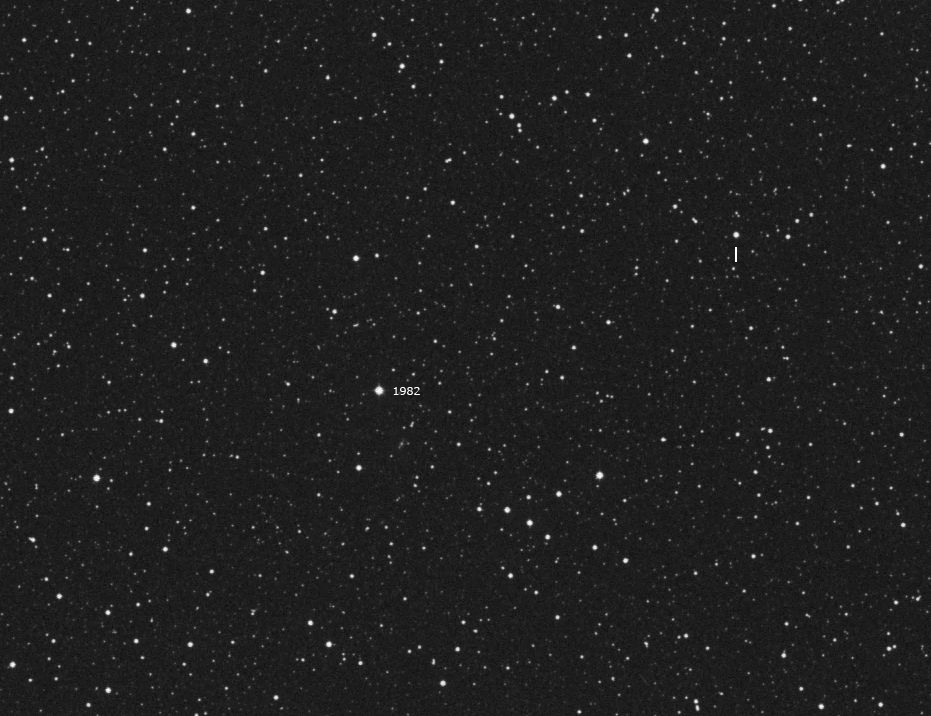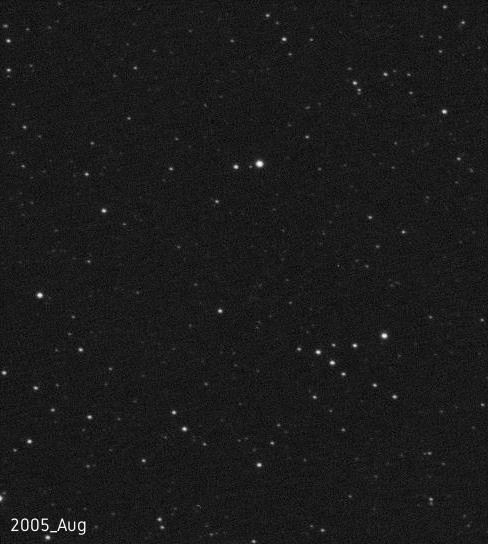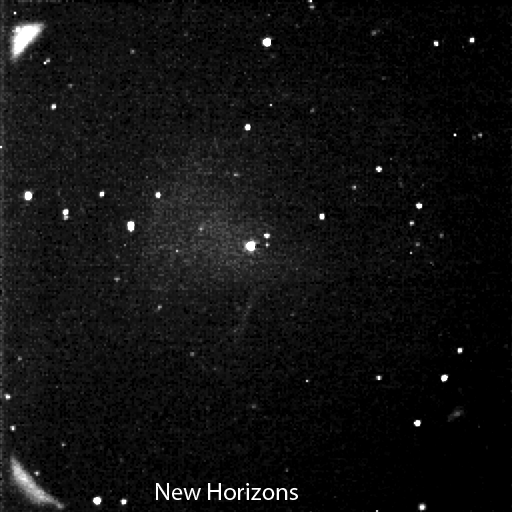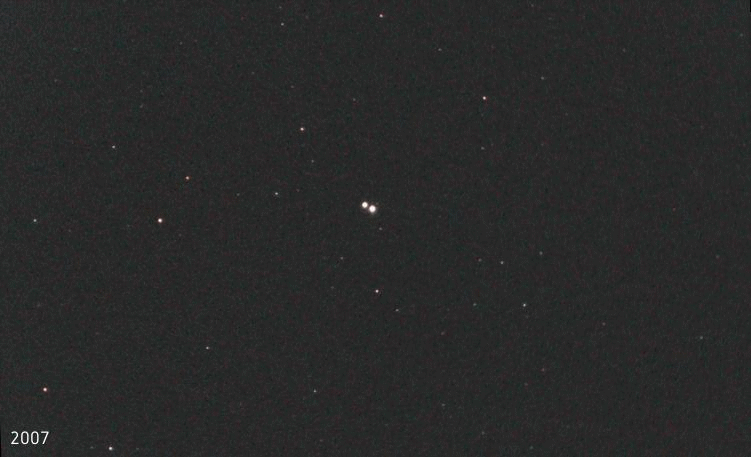Stars with High Proper Motion
Barnard's Star updated June 22, 2023
Barnard's Star is the famous high proper
motion star located in Ophiuchus.
It is a red dwarf of magnitude 9.5 with a proper motion of 10.3
arc seconds per year moving almost due North.
Barnard's Star is about 6 light years away making it one of the closest stars to Earth.
My good friend Jerry Watson, who has now passed away, introduced me to this fascinating object
over 35 years ago and I have been following it ever since.
Overall view with telescope and camera

This color photo of Barnard's Star was taken in 2021 with my TeleVue Genesis 4" f/5 refractor telescope
and an ASI294mc-pro camera. North is at the top.
The field of view of the telescope and camera combination is 2.1 degrees wide by 1.5 degrees tall.
Being close to the central band of the Milky Way,
this photo shows that Barnard's Star is just one faint star among thousands of others.
The box in the photo above shows the approximate field of view of the two animations below.
Barnard's Star is arrowed.
Also notice the "Flying Wedge" asterism inside the box.
This left pointing feature is important in finding Barnard's star.
In 1960, the Flying Wedge was pointing directly at Barnard's star.
Click on the image for a larger view in a new window.
40 year animation of Barnard's Star

This image shows the movement of Barnard's Star over the period of 40 years.
The field of view is 26' x 20' with north at the top.
Over the 40 years, the star has moved 185 arc seconds or 3.1 arc minutes.
The first image was taken in 1982 for the STscI Digitized Sky Survey
using the 48" Schmidt camera on Palomar Mtn.
The second image was taken by me in Cary, NC with my Genesis telescope and ASI1600mm camera.
Barnard's Star is not the only moving star in this animation, there are several others.
In the upper right of the animation, just above a tic mark is the most prominent moving
star other than Barnard's. You can see it shifting slightly from the upper right to the lower left.
Click on the image for a larger view in a new window.
18 year animation of Barnard's Star

The image above is an 18 year animation made from 18 different photos
of Barnard's Star taken with my own equipment.
I used two different telescopes, and 4 different cameras over the 18 years
between 2005 and 2022.
All the photos used in this animation are crops of the original frames.
The majority of the images were taken with my Genesis refractor and a SBIG ST-402me CCD camera
which has a very small sensor with 9 micron pixels.
Most images are black and white and a few are color.
The last few years, I was using ZWO ASI cameras with much smaller pixels and much bigger sensors.
The newer cameras gave better resolution on my photos.
Seeing conditions and focus varied over the years, so attempting some kind of normalization
between all the photos was very challenging.
A faint galaxy can be seen just above and to the left of the "Flying Wedge".
Back to the top of the page
Back to Mark's Astrophotography Home
The Parallax of Wolf 359 - April 18 and 23, 2020

Back in the early spring of 2020,
NASA put out a call to amateur astronomers to participate in the New Horizons' Parallax program.
Recall that New Horizons was the spacecraft which flew by Pluto and sent back all those fabulous photos.
Back on April 23, New Horizons took photos of Wolf 359 and Proxima Centauri
which are two of the closest stars to Earth.
NASA asked amateurs to take photos of their own on the same day to compare with New Horizons' images.
Since we can't see Proxima from NC, I decided to take a photo of Wolf 359 in Leo.
Because of the threat of bad weather,
I took my photo a few days early on April 18, just before midnight.
I have been patiently waiting ever since for New Horizons to transmit its data back to Earth and for NASA to publish it.
Finally the week of June 8, 2020 NASA published their data and I matched my image with theirs.
The New Horizons image shown here was 3 different 5 second images from the LORRI camera median combined together
to eliminate lots of cosmic ray strikes on the detector.
I doubled the image size because the originals were pretty small.
My image was an average of 15 exposures of 15 seconds each taken from home with my ASI1600mm camera mounted to a 4" refractor telescope.
It was difficult to align my images with New Horizons' images because of the different image scales and for some reason
the New Horizon image was mirror reversed.
After the alignment, I created an animation with Photoshop which blinks New Horizons image with mine.
It clearly shows the parallax created by the baseline distance from the Earth to the New Horizons spacecraft - out to Wolf 359.
I thought it was a pretty cool project.
For more information from NASA on the project
For a summary from Sky and Telescope Magazine click here
Back to the top of the page
Back to Mark's Astrophotography Home
61 Cygni

61 Cygni - "The Flying Star". Images taken on Sept. 9, 2007, Dec. 25, 2008, Sept. 12, 2010, July 16, 2014, Sept. 26, 2021 and July 11, 2023. This animation is of the pretty orange pair of stars known as 61 Cygni. The double is well resolved in small scopes. What also makes this interesting, especially for me, is that this is another object with a high proper motion. It moves 5.2" per year and is only 11.1 light years distant from Earth. These images were made through my Genesis refractor, my ST-402 CCD camera (LRGB), my Canon XTi, and ASI294mc (latest two images).
Back to the top of the pageBack to Mark's Astrophotography Home
Lalande 21185 Ursa Major - updated May 30, 2024

Lalande 21185 taken on July 16, 2014, Feb. 27, 2016, and June 15, 2019, and May 30, 2024.
Lalande 21185 is the bright moving star (a red dwarf) near the center of the photo.
It is one of the nearest stars to Earth at only 8.3 light years away.
It is located in southwest Ursa Major not far from Leo Minor.
It has a proper motion of 4.78 arc seconds per year and a visual magnitude of 7.6.
The images were taken using my TeleVue Genesis refractor and my Canon XTi and ASI294mc-pro.
Details:
Location: Front yard Cary, NC
Camera: Canon XTi, ASI294mc-Pro
Exposure: 2014 and 2016 Canon XTi 10x30 second sub-exposures at ISO 800
Exposure: 2019 ASI294mc-pro using 15 x 15 second exposures at unity gain
Exposure: 2024 ASI294mc-pro using 30 x 15 second exposures at gain 150
Filter: UV/IR
Scope: TeleVue Genesis 4" f/5 refractor
Mount: Losmandy G11, iOptron GEM-45
Guider: Orion 60mm finder/guider
Capture software: APT, ASIAir
Guiding software: PHD,ASIAir
Calibration frames: darks, flats, flat-dark
Processing software: Pixinsight, Photoshop CC, GradientXterminator, NoiseXTerminator, GIF Animator
Weather conditions:
Notes: This image is cropped. North is to the right.
Back to the top of the page
Back to Mark's Astrophotography Home